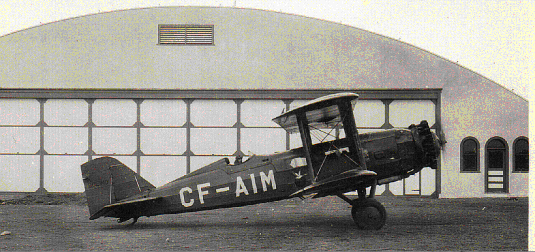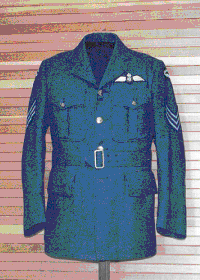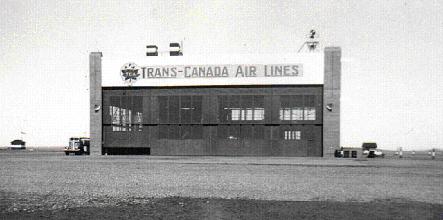
The aviation industry has a long and notable history in Lethbridge. The city's first airport was at the Horse Racing Track. In 1911 and 1918, Eugene B. Ely and Katherine Stimson, who were stunt pilots put on flight shows that amazed the people gathered at the track. On August 7, 1919, Ernest C. Hoy landed in Lethbridge after making the first flight across the Rocky Mountains from Vancouver to Lethbridge.

P19800142007-GP Lethbridge's airport, Kenyon Field
Commercial aviation came to Lethbridge in 1922 when John Ender (Jock) Palmer and Harry H. Fitzsimmons formed the Lethbridge Aircraft Company. The men ran a regular passenger service in Lethbridge and even attempted an international airmail flight from Lethbridge to Ottawa, but failed when the plane crashed in Minot, North Dakota. Aside from this other pilots soon followed the lead of Palmer and Fitzsimmons. Charles Elliott, Charles Tweed, and Wilfred Rutledge all operated out of Lethbridge's airfield during the 1920's. The airfield then being used was known as the Fairmont Subdivision. Located northeast of the city, it was an old airfield lacking even the most basic radio and lighting equipment.

P19760238014-GP An airmail flight arrives at Lethbridge
Pressure grew in the 1920's to improve the Lethbridge airfield. Emil G. Sick of the Lethbridge Breweries and Charles Elliott were two of the key people involved in improving the air field. Elliott was the head of Lethbridge Commercial Airways Limited which operated a pilot training centre and offered some charter passenger service. His company, which was later renamed Southern Alberta Airlines, pressed city council to put telephones and floodlights in the air field. In 1930, when the post office made Lethbridge a stop on its new trans-prairie airmail service, council took action on improving the airfield. In June of that year, the city agreed to spend $20 000 on the purchase of a floodlight, a hangar, and fences. At the same time, the federal Department of Transportation installed a meteorological station and beacon at the airfield. Herbert Hollick-Kenyon officially began airmail service to Lethbridge on January 15, 1931 when he landed his Canadian Airways Fokker monoplane at the Lethbridge Municipal Airport.
At first, commercial air service in Lethbridge did not meet the expectations of its supporters. Alberta airlines, such as Rutledge Air Service of Calgary and Commercial Airways of Edmonton, failed to get airmail contracts or U.S. passenger services. Because of this, Lethbridge Municipal Airport was used only for airmail delivery and recreational flight during the 1930's.

P19861065001-GP, A view of the buildings used to house the No.8 Bombing and Gunnery School at Kenyon Field, Lethbridge.
A new chapter in Lethbridge's aviation history began in 1937 when the city bought 295.6 hectares of land south of the city from the CPR. This land was used for the construction of a new airfield station which included two hard-surfaced runways, a hangar, a radio and meteorology station, and a radio range base. When it officially opened in June of 1939, the new airfield was named Kenyon Field, in honour of Herbert Hollick-Kenyon,
Lethbridge received fairly good air-passenger service in the years that followed the construction of Kenyon Field. Two daily North-South flights were provided by Western Air Express. Lethbridge was also on Trans-Canada Airlines' East-West transcontinental route. The city was in a good location to receive air traffic arriving from or leaving on the long journey across the Rockies.

Service Dress Jacket of the R.C.A.F., rank displayed on this particular uniform is Sergeant. Uniform courtesy of Edward J. Litton, Lethbridge.
World War II resulted in an even greater need for the aviation industry in Lethbridge with the military becoming the main user of Kenyon Field. The air field was the site of the No. 5 Elementary Flying Training School, a part of the British Commonwealth Air Training Plan (B.C.A.T.P.). 35 officers and 65 civilian instructors were brought in to run the school and many new buildings were constructed for the training and housing of the instructors and trainees. Kenyon Field also served as the grounds for the No. 8 Bombing and Gunnery school. The Air Force spent $620 000 on lengthening and strengthening the runways, to make them ready for military training. At the height of these operations, Kenyon Field employed 1 600 people and included an on-site hospital.
In the years that followed World War II, Lethbridge's position as a regional air centre decreased as regional carriers pulled out of the airport and traffic disappeared. In March of 1967, the federal government bought the airport from city council. Still, air traffic in Lethbridge continued to decrease. In 1970, Air Canada, the last major carrier in Lethbridge, pulled out of the city. This caused concerns that the Kenyon field would be closed.

P19901049019-GP Trans-Canada Air Lines hangar at Kenyon Field, the hangar is still in use today.
Fortunately, Walter R. (Stubbs) Ross' airline, Time Air, stepped in to takeover the routes that Air Canada did not want anymore. Ross came from a ranching family in southeastern Alberta, but his hay fever had made him unable to work in ranching. Instead, Ross put his energies into aviation. He became president of the Flying Farmers of America and formed Lethbridge Air Service which was a small carrier service that provided eight seat passenger service from Lethbridge to Calgary.
For Ross, Air Canada leaving Lethbridge gave him a chance to expand his business. He was successful in getting city councils’ support in obtaining a five-year commercial aviation license from the Department of Transport. The license made it easier for Ross to get investment the capital that made the purchase of larger planes possible. Time Air grew and expanded its business until 1983 when the company sold off 40% of its shares to a major carrier. In 1984, Ross quit as chairman of the airline and became an advisor to the company. Stub Ross passed away three years later at the age of 56. By 1987, Time Air had grown from a small one-man operation into a large commercial airline that employed over 150 people in Lethbridge.
Previous Page | Exhibit Contents | Home | Navigation Information | Glossary | Curriculum Guide | Next Page
Copyright © 1996 Sir Alexander Galt Museum. All rights reserved.